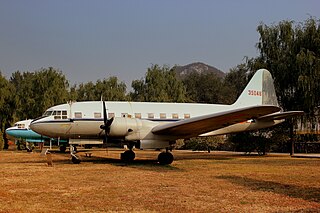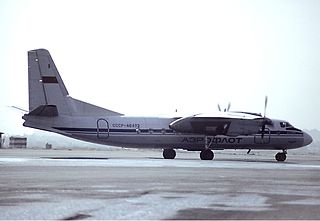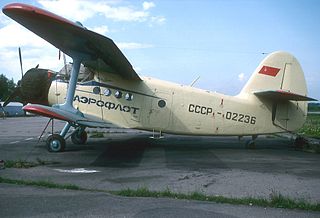
Ust-Kut Airport is an airport in Irkutsk Oblast, Russia which is located 9 km north of Ust-Kut. It services short-haul routes and links the town to Irkutsk and Krasnoyarsk.

Abakan International Airport is an airport located in Abakan, Republic of Khakassia, Russia.

The Ilyushin Il-12 is a Soviet twin-engine cargo aircraft, developed in the mid-1940s for small and medium-haul airline routes and as a military transport.
Aviaarktika was a Soviet airline which started operations on 1 September 1930 and was absorbed by Aeroflot on 3 January 1960.

On 11 August 1979, a mid-air collision occurred over the Ukrainian SSR, near the city of Dniprodzerzhynsk. The aircraft involved were both Tupolev Tu-134As on scheduled domestic passenger flights, operated by Aeroflot. All 178 people aboard both aircraft died in the accident.

Aeroflot Flight 141 was an international flight from Moscow to Prague. On 19 February 1973, the Tupolev Tu-154 crashed 1.5 kilometres short of runway 25 of Prague Ruzyně Airport. Most of the passengers survived the crash, but many died in the fire that followed. Out of the 87 passengers and 13 crew members, 62 passengers and 4 crew members perished with 18 occupants having serious injuries and the remaining 16 with either minor or no injuries. The crash was the first loss of and first fatal accident involving the Tu-154.

Aeroflot Flight 25 was a scheduled domestic passenger flight that crashed on 4 April 1963 in the region of Rybnaya Sloboda, Tatar ASSR, Russian SFSR while en route from Moscow-Sheremetyevo to Krasnoyarsk Airport, Russian SFSR. All 67 people aboard were killed in the accident.

Aeroflot Flight 15 was a passenger flight from Moscow-Domodedovo Airport to Petropavlovsk-Kamchatsky Airport with a stopover at Yemelyanovo Airport that crashed on 29 February 1968 en route to Petropavlovsk. All but one aboard the aircraft were killed in the crash.

Aeroflot Flight 721 was a scheduled domestic passenger flight between Moscow and Yuzhno-Sakhalinsk in the Russian SFSR. On Wednesday, 2 September 1964, the aircraft flying this route, an Ilyushin Il-18V, crashed into the side of a hill on approach to Yuzhno-Sakhalinsk, killing 87 of the 93 people on board. At the time of the accident, it was the deadliest Il-18 crash and the deadliest aviation accident on Russian soil.

Aeroflot Flight 3519 was a scheduled flight, operated by a Tupolev Tu-154B-2 that crashed on December 23, 1984 due to an engine failure, 110 occupants were killed; one passenger had survived the accident.

Aeroflot Flight 5484 was a scheduled domestic passenger flight from Odesa to Kazan with a stopover in Kyiv that experienced loss of control followed by breaking up in the air on 29 August 1979 over the Tambov Oblast, killing all 63 people on board. It remains the deadliest Tu-124 crash and regular passenger services with the Tu-124 were permanently suspended after the accident, but the Tu-124 was still used by the Soviet military after the accident.

Aeroflot Flight 1661 was a passenger flight operated by an Antonov An-24 that crashed during its initial climb, 25 minutes after take-off from Tolmachevo Airport on 1 April 1970. All 45 people on board perished. An investigation revealed that the Antonov collided with a radiosonde, causing a loss of control.

The 1953 Kemerovo mid-air collision was an aviation accident where two Li-2 aircraft collided over Kemerovo Oblast, Soviet Union, on May 27, 1953, resulting in the deaths of all 27 people aboard both aircraft.

The 1951 Aradan Aeroflot An-2 crash was an aviation accident that occurred on 21 April 1951. An Antonov An-2 aircraft, operated by Aeroflot disappeared on a flight from Kyzyl to Abakan with four crew on board. The incident was the first fatal loss of the Antonov An-2. The aircraft's wreckage was not located until 2009 and was positively identified in 2019.












